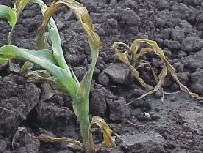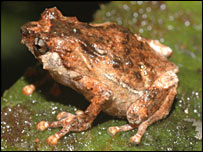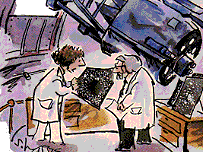| Hypothesis and Alternative Hypothesis |
|
| Making a Hypothesis: When a scientist observes something, he tries to explain how it could have happened. The explanation he proposes should also take into account what is already known about that which he observed. |
|
Explanation and Hypothesis: The scientist tests the hypothesis using an experiment with controls. For instance, if you observe a plant wilt and die during a summer drought, a reasonable explanation is that water is necessary for plant success. Scientifically testing that explanation involves two hypotheses: a null hypothesis and an alternative. The null hypothesis implies that the presumed factor being tested has no effect (i.e., "null"). The alternative hypothesis states that the presumed relevant factor has the effect embodied in the explanation of what was observed.
|
| The Test: Grow two plants (or better, two replicate groups of plants) in pots close by each other so that they experience all the same conditions except for the one you intend to test. Water one set of plants and don't water the other (to simulate the "natural" circumstances in one case and drought in the other). The watered plants are the experimental group and the non-watered plants are the control group in which the presumed relevant factor is absent. If the drought plants wilt and die but the watered plants flower and set seed, then the null hypothesis is rejected in favor of the reasonable alternative. Notice that the alternative hypothesis is "proved" indirectly by obtaining strong enough evidence to reject the lack of effect stated by the null hypothesis. If the test is performed again in the same way, the same outcome is expected because the conditions are the same. When the hypothesis is repeatedly shown to be true, it can be considered a scientific theory based on consistent evidence that always produced the same result. |
| Origin of Life: Life exists on Earth, but we do not know the details of its origin here. If natural laws are always valid - they apply in the same way at the beginning, in all historical times, now, at all locations in the universe, and will apply in the future - then we can observe how they work here and now, knowing that the results of their actions would have been the same at the beginning. When we construct a microcosm of the basic building molecules of life and add a source of energy, we discover that in a short amount of time the initial inorganic molecules react to form organic materials, i.e., amino acids. A reasonable explanation for this observation would be that inorganic molecules obey universal laws of physics and chemistry and will always produce organic molecules when those inorganic molecules are exposed to an appropriate source of energy. The null hypothesis for testing this observation would be that a source of energy is not sufficient to cause inorganic chemicals to form organic molecules. An alternative hypothesis would be that organic molecules will always result from appropriate ingredients exposed to energy. Since organic molecules did result, and continue to result whenever the experiment is repeated, we reject the null hypothesis and conclude that the laws of nature are universally valid and we can predict the results of their action if we know those laws. |
|
Appropriate Hypothesis: When Francisco Redi did his experiment concerning spontaneous generation, the setup for his experiment included two groups of flasks, all containing fresh meat. The conditions for all the flasks (temperature, wind, light, length of time for the experiment, etc.) were the same except one. The flasks in the control group had covers (i.e., the presumed relevant factor was absent) and those in the experimental group did not. The condition that was different for the two groups of flasks was access to flies. Therefore, the null hypothesis for Redi's experiment was that, under the prevailing environmental conditions in which the flasks were placed, adult flies were not necessary for young flies to appear on the meat. |
| Spontaneous Generation: Redi's experiment was a test of the general principle that new life arises only from previous life. He used the specific example of young flies produced from adult flies. The results of the experiment were extrapolated to all forms of life. However, proving the hypothesis universally true would have required that every form of life would have to be tested. Since it was impossible to test every species to prove the hypothesis true, the null hypothesis was rejected on the basis of the one example. The result that flies could not arise except from their parents was assumed to be valid for all other species. We accept that hypothesis until we find additional, verifiable evidence that refutes it. |
Useful Alternatives: For every hypothesis, there is at least one alternative hypothesis and sometimes many more.  A good alternative hypothesis is specific to the conditions of the experiment, and its acceptance upon rejecting the null hypothesis offers a possible explanation of what was observed based on evidence obtained by a verifiable process. The null hypothesis in Redi's experiment, that adult flies were not required to produce maggots, was rejected and eliminated the notion that the maggots arose out of the meat itself - or generated by decaying vegetation, or manure, or swamps, etc. Progress was achieved because evidence was collected that could discriminate between those two competing hypotheses. A far-fetched alternative hypothesis that would divert our attention from the central question, would not provide assistance in our understanding of life's processes, and for which we could not collect evidence to reject it, would be that in the middle of the night aliens from another planet placed the maggots in the meat (or that a fairy godmother waved a wand). A good alternative hypothesis is specific to the conditions of the experiment, and its acceptance upon rejecting the null hypothesis offers a possible explanation of what was observed based on evidence obtained by a verifiable process. The null hypothesis in Redi's experiment, that adult flies were not required to produce maggots, was rejected and eliminated the notion that the maggots arose out of the meat itself - or generated by decaying vegetation, or manure, or swamps, etc. Progress was achieved because evidence was collected that could discriminate between those two competing hypotheses. A far-fetched alternative hypothesis that would divert our attention from the central question, would not provide assistance in our understanding of life's processes, and for which we could not collect evidence to reject it, would be that in the middle of the night aliens from another planet placed the maggots in the meat (or that a fairy godmother waved a wand). |
Reasonable Hypothesis: There was once a time when unexpected disaster, e.g., disease, struck a community and a person accused of being a witch was burned at the stake. Before good public health practices were developed and before it was understood that germs caused diseases, it was common to attribute disease to miasma. With accumulating knowledge and better understanding of nature, our hypotheses tend to be more in touch with reality. However, there are examples in which society was too wrapped up in faulty hypotheses to recognize the key to answering controversial questions, e.g., the cause of cholera, the genetic basis of inheritance. When we suggest the correct hypotheses and collect discriminating evidence,  we will continue to answer the burning questions that we now debate in ignorance of detail and we will continue to make progress. we will continue to answer the burning questions that we now debate in ignorance of detail and we will continue to make progress. |
|
Click  above for a sample test of hypotheses. Click above for a sample test of hypotheses. Click  above for a sample quiz question. above for a sample quiz question. |


